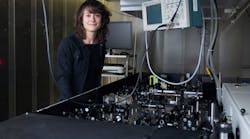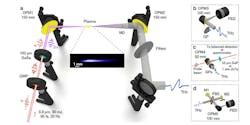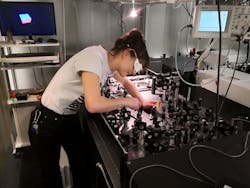IR Laser Mixing, Optical “Magic” Yields THz Waves with Relative Efficiency
The terahertz segment of the electromagnetic spectrum exists in a sort of “twilight zone” between about 300 GHz (0.3 THz) to 3 THz (note that the upper boundary value is somewhat arbitrary, and some consider it to be 30 THz). It’s bounded below by millimeter-wave RF (30 to 300 GHz) and above by optical wavelengths. Electromagnetic radiation below the terahertz band can be created by many sources and emitted by antennas, while the optical radiation above the terahertz band can be developed by solid-state lasers.
However, the major part of the terahertz span is largely a void. Although it’s governed by Maxwell’s equations just as the rest of the spectrum, it’s relatively difficult to generate these waves as they’re too high in frequency for even most leading-edge electronic components and too low for optical sourcing. Due to this and other problems, the terahertz region is far less explored and exploited than the RF or optical areas (see “References” at end of article).
Why even investigate the terahertz part of the spectrum? Among the many reasons are because it’s there, of course; because it potentially has useful and fascinating characteristics; and it may be needed for 6G, 7G, or 8G wireless links. After all, 20 years ago, if you had told someone that there would be mass-market consumer products operating at ~10 GHz by the first part of the 21st century, you would have likely been called a wild-eyed dreamer.
Power Problems
However, the problem remains in terms of efficiently generating useful levels of power in the terahertz band. There are tabletop sources based on either optical rectification in electro-optic crystals or two-color filamentation in gases and liquids. With optical rectification, terahertz pulses with energy up to 0.9 mJ and THz conversion efficiency (ratio of generated THz energy to the input laser pulse energy) up to 3.7% have been generated, but the pulses are long (several picoseconds) with narrow spectra.
Unfortunately, the optical-damage threshold of electro-optic crystals prevents a significant increase in power. Furthermore, while there are no issues with optical damage when using the two-color filamentation approach, it generates only less-energetic near-infrared (NIR) laser pulses, and with a very low conversion efficiency of ~0.01%.
Efficient Source Breakthrough
Now, a research group based at TU Wein (Vienna University of Technology), in close cooperation with a team from the Institute of Electronic Structure and Laser (IESL) Foundation for Research and Technology-Hellas (FORTH) in Heraklion, Greece, and some help from Texas A&M University at Qatar, has developed a source that’s both fairly efficient and can generate waves across the entire terahertz slice of spectrum. The experiment, with results they claim has broken previous records in these areas, was inspired by a theory developed in Texas A&M University, which predicted that long-wavelength laser pulses could be used to achieve extremely efficient terahertz generation in air plasma.
In the setup schematic (Fig. 1), the generation of the terahertz waves begins by sending infrared laser light through a nonlinear medium, where part of the infrared radiation is transformed into optical radiation at twice the initial frequency. The two radiation waves are then superimposed, creating an electromagnetic wave with an electric field having a very specific asymmetric shape.
But that’s only the start of this process. The intense wave “rips” electrons out of the molecules in the air, turning the air into a glowing plasma. The special shape of the wave's electric field accelerates the electrons in such a way that they produce the desired terahertz radiation.
As noted by team member Claudia Gollner (Fig. 2), “Our method is extremely efficient with 2.3% of the supplied energy converted into terahertz radiation. That is orders of magnitude more than can be achieved with other methods. This results in exceptionally high terahertz energies of almost 200 microjoules and terahertz-field amplitudes exceeding 100 MV per cm.”
She also added that their approach develops many wavelengths throughout the terahertz range to be emitted simultaneously, and the larger spectrum of different terahertz wavelengths yields the shorter and more intense pulses.
The details, including a review of existing methods of terahertz generation and their characteristics, are in their paper “Observation of extremely efficient terahertz generation from mid-infrared two-color laser filaments” published in Nature Communications, along with even-more detailed, equation-laced Supplementary Information.
References
IEEE Spectrum, “Wireless Industry’s Newest Gambit: Terahertz Communication Bands”
IEEE Spectrum, “Terahertz Waves Could Push 5G to 6G”
IEEE Spectrum, “The Truth About Terahertz”


